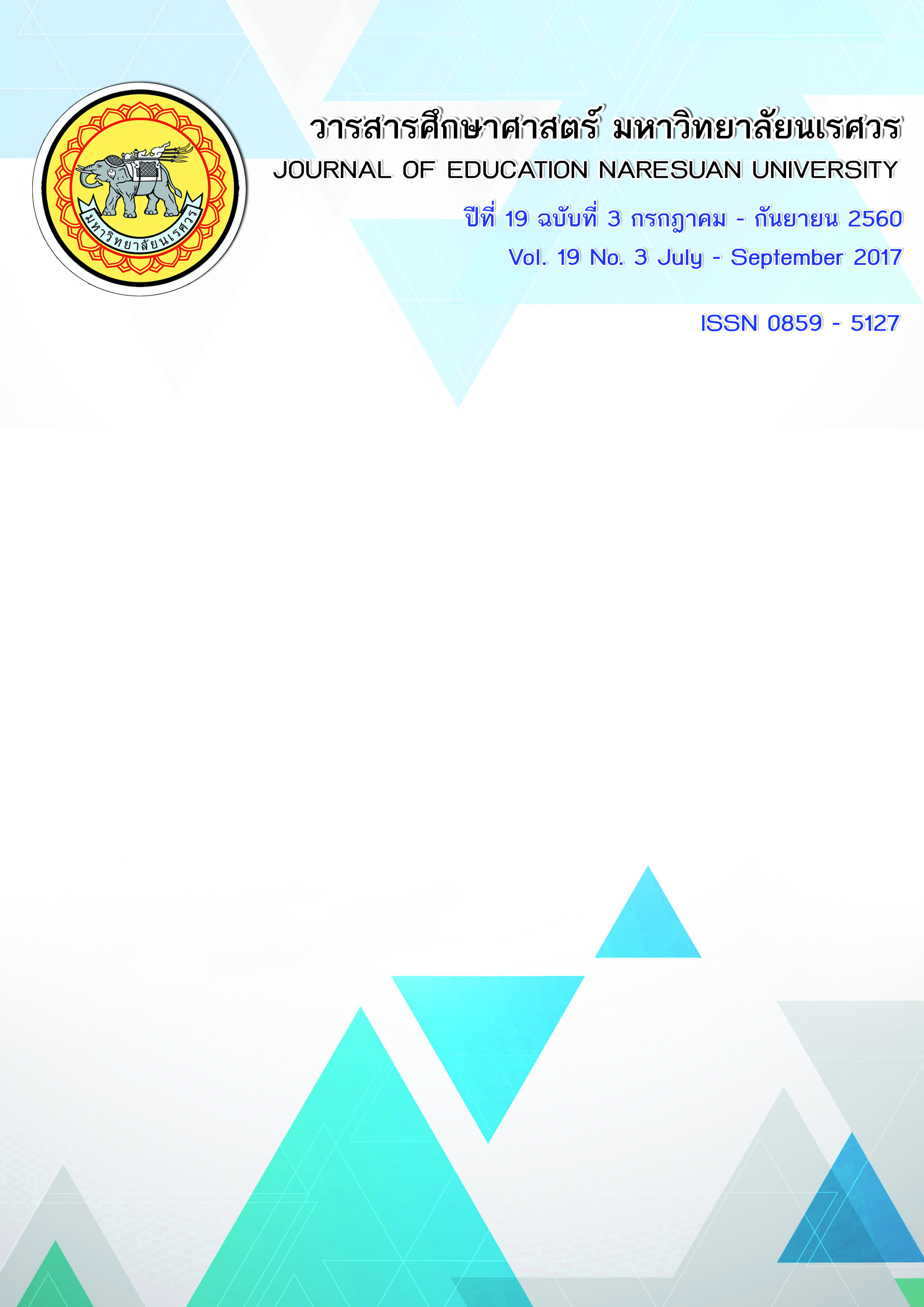การพัฒนาแบบวัดความสุขของผู้เรียน สังกัดสำนักงานเขตพื้นที่การศึกษาประถมศึกษาในภาคตะวันออก
Main Article Content
Abstract
การวิจัยนี้มีวัตถุประสงค์เพื่อสร้างและตรวจสอบคุณภาพแบบวัดความสุขของผู้เรียนและสร้างเกณฑ์ปกติ กลุ่มตัวอย่าง ได้แก่ นักเรียนชั้นประถมศึกษาปีที่ 6 สังกัดสำนักงานเขตพื้นที่การศึกษาประถมศึกษาในภาคตะวันออก ปีการศึกษา 2557 จำนวน 2,307 คน ได้มาโดยการสุ่มแบบหลายขั้นตอน เครื่องมือที่ใช้ คือแบบวัดมาตรประมาณค่า วิเคราะห์ข้อมูลโดยการตรวจสอบความตรงเชิงเนื้อหา ค่าอำนาจจำแนก การทำหน้าที่ต่างกันของข้อคำถาม ค่าความเชื่อมั่น วิเคราะห์องค์ประกอบเชิงยืนยัน และสร้างเกณฑ์ปกติ ผลการวิจัยพบว่าแบบวัดมีค่าอำนาจจำแนกระหว่าง .262 - .597 ดัชนีการทำหน้าที่ต่างกันของข้อคำถาม (^*) จำแนกตามขนาดโรงเรียนมีค่าระหว่าง - .243 - .264 เหลือข้อคำถาม 97 ข้อ มีค่าความเชื่อมั่นทั้งฉบับและแต่องค์ประกอบ อยู่ระหว่าง .866 ถึง .934 โมเดลการวัดองค์ประกอบความสุขทั้ง 4 องค์ประกอบมีค่าน้ำหนักองค์ประกอบของตัวแปรสังเกตได้มีค่าแตกต่างจากศูนย์อย่างมีนัยสำคัญทางสถิติที่ระดับ .01 ทุกค่าแสดงว่าโมเดลมีความตรงเชิงโครงสร้าง มีความสอดคล้องภายใน มีความตรงในการลู่เข้าและสอดคล้องเหมาะสมดีกับข้อมูลเชิงประจักษ์ (ค่า
2 = 106.842, df = 85, p = .055,
2/df = .080, RMSEA = .017, NFI = .997, NNFI = .999, CFI = .999, RMR = .016, SRMR = .06, GFI = .987, AGFI = .972, PGFI = .542,
c = .963 และ
v = .578) โมเดลไม่แปรเปลี่ยนตามเพศและขนาดโรงเรียน เกณฑ์ปกติวิสัยจำแนก เป็น 5 ระดับ ได้แก่ ระดับมากที่สุด ระดับมาก ระดับปานกลาง ระดับน้อย และระดับน้อยที่สุด โดยคะแนนปกติวิสัยมีค่าเฉลี่ยเท่ากับ 313 คะแนน
A DEVELOPMENT OF HAPPINESS SCALE AS PERCEIVED BY STUDENTS IN SCHOOLS UNDER PRIMARY EDUCATIONAL SERVICE AREA OFFICE IN EASTERN OF THAILAND
The purposes of this research were to develop, to validate the quality of a happiness scale as perceived by students in schools under primary educational service area office in eastern of Thailand., and to construct the norm The sample involved 2,307 Prathomsuksa 6 students in academic year 2014 selected by Multi-stages random sampling. The instrument was used the rating 4 scales questionnaire. The data analysis for the discrimination, the differential item functioning analysis, the reliability, the confirmatory analysis and constructing the norm. The research findings were the items of happiness scale discriminations varied from .262 to .597, the differential item functioning indicated that the DIF index (^*) of the rating scale test, classify by school size, varied from -.243 to .264. Finally there were 97 items within the test. The Cronbach’s alpha coefficient were .866 to 906, The quality of validation found that; The 4 factors of happiness scale model fit to empirical data. Every factor loading of observed variables were significantly different from zero at .01 level.
The model has construct validity, internal consistency, convergent validity and fit to empirical data. It provides these statistic: 2 = 106.842, df = 85, p = .055,
2 /df = .080,
RMSEA = .017, NFI = .997, NNFI = .999, CFI = .999, RMR = .016, SRMR = .06, GFI = .987, AGFI = .972, PGFI = .542, c = .963, and
v = .578 and the model invariance of model form when classify by sex and school size. The Norm classify 5 levels, the most, more, moderate, less and the least. The average score was 313 points.
Article Details
The owner of the article does not copy or violate any of its copyright. If any copyright infringement occurs or prosecution, in any case, the Editorial Board is not involved in all the rights to the owner of the article to be performed.


